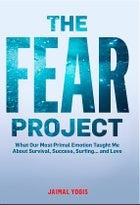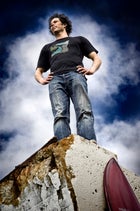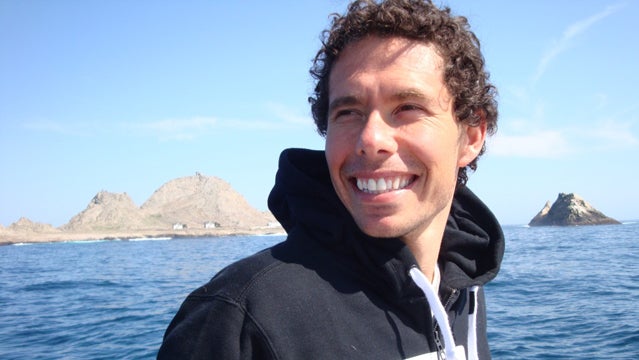Most big-wave surfers dream about surfing Mavericks, the colossal break near the shores of Half Moon Bay, south of San Francisco. Given the lives claimed in those cold Pacific waters and the locomotive force of Mavericks waves, which can reach 80 feet, those dreams are surely mixed with a healthy dose of dread. They were for Jaimal Yogis, a 33-year-old writer and surfer who lives in San Francisco. But he managed to turn those fears and that surfing dream into an assignment. For (Rodale), Yogis spent months training for a go at Mavericks.
 The Fear Project.
The Fear Project. Jaimal Yogis.
Jaimal Yogis.Along the way, he steeped himself in the latest neuroscience on fearÔÇöwhere it comes from, why we have it, what’s good and bad about itÔÇöand connected what we know about fear with what we feel about fear, whether that’s the fear of a big wave or a guitar solo or a committed relationship.
As the story develops, Yogis finds the love of his life and by the close of the book he has become a father. Somewhat less importantly, he has also surfed Mavericks.
From just sitting in the lineup to being in the grip of a two-wave hold-down courtesy of a rogue wave, Yogis’ descriptions of his inaugural Mavericks session make fear palpable. About his second hold-down he writes: “An avalanche of foam mows me down and I’m back into blackness: punched, kicked, splayed, held under again. … I’m gagging for air, again with no sense of direction. Where the hell is the surface?”
But he is not deterred. Employing some of the mental techniques he’s been practicing for months (“positive anchoring thoughts,” for example), Yogis stays in the water and comes to terms with his fear. “Instead of feeling weaker by embracing fear, I’m flooded with a surge of power,” he writes. After hours of trying, he finally gets his wave.
We spoke with YogisÔÇöwhose first book, Saltwater Buddha, explored the linkages between surfing and Zen BuddhismÔÇöabout The Fear Project and what it says about how getting outside and facing our fears can make us smarter, reduce our stress, and keep us healthy.
Early on in the book you write about the end of a really long relationship and that break-up seems like the impetus for the whole project. Was it?
The idea first came from my book tour for Saltwater Buddha. I had a big book tour because I had a small publisher and I knew that if I wanted to sell books I would need to do a book tour. Just the idea of public speaking made me really nervous. I sort of assembled all these mechanisms to make me less nervous. I brought my friend’s band on tour with meÔÇöthey would play at the bookstore and they have a really groovy, mellow sound, so that would relax me. And I would lead a brief meditation before giving my talk. Both of those would calm me down.
The first couple of stops were pretty bad, but then I started getting into it and I realized that it was fun. That just seemed like magic to meÔÇöthat I could be so nervous about something and then all of a sudden I could just do it. If I can have a blast public speaking, what else am I not doing that could help me live more fully, more successfully, more freely?
I thought, well, I’d always wanted to surf Mavericks, maybe I could include that as sort of a Trojan horse that carries the narrative for a book. I played around with this idea and I did some research on fear. I got a hold of this one quote from Eleanor Roosevelt; she said “Do one thing every day that scares you.” That started echoing in my head. The last book I’d pitched had been rejected and I was scared of being rejected again but I decided that my one scary thing every day would be to start pitching this idea. So I pitched it first to this woman I had heard about who is a senior editor at Rodale who loves surfing. A week later we were making a book deal. So it felt like the universe was responding or something.
All this time I was also going through the break-up and it was intensifying things. In my first draft of the book I actually included all of thisÔÇömy anxiety about writing and doing my next bookÔÇöand my publisher was like, “people don’t care about that.” But getting over the break-up is what made writing this book a personal necessity, and relatable.
You talk in the book about neural networks and training yourself out of a negative feedback loop. You talk to a sports psychologist named Michael Lardon who helps elite athletes to basically train themselves away from negative reactions to bad performance and toward rewarding themselves for good performance, celebrating when they do something well. Is there any research that shows this would work with people who are more casual athletes rather than people who train full-time in a specific sport?
Lardon’s research is on the fact that the stronger an emotion is, the more it is singed into your memory. So enhancing a positive outcome with celebrationÔÇöhooting or just taking a deep breath and relishing a momentÔÇöthere is research showing how that lingers in the brain. But we usually do that with negative emotionsÔÇöthat’s called a negatively biasÔÇöbecause evolution taught us to prioritize threats over the safe. You can skim over the safe and still be safe, whereas you can’t skim over a threat if it’s a real threat. So those negatives are automatically singed more deeply into the brain and it’s the positives that we have to work on enhancing, or sort of turbo-charging.
In sports there are countless techniques for this kind of training. The best training is doing, but you can’t always be doing it. So the more clearly you visualize something and the more detail you bring in, the more impulses you’re actually sending to your muscles and the more chance you’ll have to pull that stunt off successfully. Most scary situations, you can’t train in them exactly, because they’re scary. You can work your way up to it, but you’re not going to put yourself in that most precarious position right away. As you’re working your way up to it, if you visualize that thing, it’s a great compliment because your brain needs to recognize a pattern.
Steven Kotler, who is another surf writer, is writing a book about flow states right now. He’s found that one of the key aspects of getting into a flow state, where you can pull off something that seems beyond your abilities, is pattern recognition. Your brain recognizes that it’s been there before. So visualization can definitely help with that.
The other technique is doing something that challenges you enough to feel some fear, where you are getting the psychological arousal that comes with fear. Fear is energy. Just like caffeine can put you in an optimal state of performance but too much can be detrimental and make you crash, a little bit of fear is just a boost of adrenaline. Also, if you’re in a new situation, you’re getting some dopamine and that’s a key part of getting to peak performance. Doing something you love is really good, too, because that’s where dopamine comes and maybe even oxytocin if you’re doing it with friends. OxytocinÔÇöthe love hormoneÔÇöcan kind of unfreeze fear.
There seems to be a cocktail of neurochemicals that are needed for those flow states, but you can’t reduce it to a formula. And you don’t have to be an extreme athlete, but pushing yourself is key. If you’re just doing the same three-mile loop run every day you’re much less likely to get into a “runner’s high” than if you, say, find a new hill that has some precarious footing where you really need to focus and challenge myself. The brain craves new challenges; it’s the key to neuroplasticity.
Just by doing any kind of outdoor exercise, you’re creating a more brave brain. That’s been found on some studies with rats, where rats that exercise are more brave when they go through labyrinths, whereas rats that are sedentary tend to hide in corners in a new environment. Exercised rats seem to build new neurons and those neurons seem to be more immune to fear.
Your first book, Saltwater Buddha, is about Zen Buddhism and finding ways to embrace life. You’d think a surfer would seek out Buddhism in response to fear, but you come at it from a different direction.
Most people get into a spiritual practice or Zen as they’re breaking down fears and I was really afraid that what I knew about my experiences with Zen might be a lie because I was having such a hard time in my life and I’d had done so much practice. I mean, 15 years of meditating every day, and doing Yoga, and I was raised by a family that was more or less BuddhistÔÇöand yet I really felt like I was hitting a wall. And so it wasn’t that I was completely distrusting of everything that I had said in Saltwater Buddha, but I had become distrustful of my own mind.
When you’re practicing Zen you’re basically in your own mind. You’re using a paradigm where the more you empty out, the more you know. And I actually believe that is true, but in crisis, fear can just shut you down, in a literal, scientific way, where your immune system and digestion and everything is shutting down, but also in a creative way, where your focus narrows so much that creative ways of dealing are limited as well.
So I did genuinely feel like I needed a clean slate. I had this notion that neuroscience and psychology were breaking down barriers of what we know. Neuroscience is also starting to come at some of these contemplative traditions with fresh information, which might help confirm some of the things that I’d been intuiting all my life but that I had lost faith in during my crisis.
And that really did happen. All the neuroscience and psychology have dropped me back off; I’m trusting myself again and I trust that humans are really intuitive about the feeling of fear.
You write about novelty-seekersÔÇöpeople who tend to look for new challengesÔÇöand the linkages between this personality type and attention deficit hyperactivity disorder. People with ADHD, such as skier JT Holmes, tend to seek out bumps of dopamine, which gets them cast as risk takers or unfocused but, you write, “in the old world, these kids probably would have been put to work as hunters or explorers and praised.” You learn from Holmes that he’s actually quite a calculating and disciplined athlete who turns fear into motivation. Are there examples of this persona outside the extreme sports arena?
Absolutely. I think Silicon Valley is a perfect example. It’s a cutting-edge business environment that’s all about risk and failure and allowing yourself to take risk and allowing yourself to fail. Washington, D.C., is modeled around fear and they have to be to a certain extentÔÇöthey have to be conservativeÔÇöbut if we’re going to evolve as a country we really need the risk takers to do the opposite and push innovation.
I don’t think that kind of risk is going to satisfy every kind of adrenaline junky out there, but you don’t have to be a professional extreme skier to get your rocks off. Most of us who do outdoor sports, we don’t do them professionally, but doing those sports might help us keep our sanity at work. I’m not a professional surfer but if I didn’t surf most days and push myself there’s no way I could sit in front of a computer for six hours and type words. It would drive me bonkers.
I think a lot of people don’t admit that they want to be doing some adventuring, and that it would keep them sane, but they say, “No, I can’t afford that” or “I need to stay put at my desk.” I think if they did go out there and push it, they might find themselves more productive at work, or more healthy. It doesn’t have to be danger with a capital D. ADHD diagnoses are up and so are the number of kids on medications. These kids are on amphetamines.
You’re a new parent, and even though your son is just 11 months old, how will you teach him about fear?
Parenting complicates fear tremendously. I have a lot of thoughts about that. One is that I absolutely want to foster his natural exploration and nurture that and understand that it’s part of his learningÔÇöhe needs to scrape his knee and bump his head along the way. My wife and I talk all the time about how we don’t want to be helicopter parents, but want to be safe.
I don’t want to be a role model of a daredevil for him. If he’s inclined to things like that I want to make sure he understands why. That was a big thing for me, writing this book. Yes, I wanted to surf Mavericks and there was a pure part of me that wanted to do that for the experience and for the spiritual aspect of facing death and there was another part of meÔÇöthat I didn’t understandÔÇöthat was all about wanting to be accepted into this elite club, and this adolescent drive to be popular among my surf peers. I think a big part of me was driven by that and in retrospect it seems silly, and maybe I needed to go through it just to see that.
Fear is complex and I am grateful to understand it a little bit better so that I can hopefully nurture the positive fear in my son and point out what is pointless and urge him to take risks. The things that stress me out are usually socialÔÇöwhat are people going to think of my book, or did I say the wrong thing at a dinner party. Those are the fears that tend to twist us into chronic stress, which is most debilitating to our health. So I’m trying to expose him to lots of social situations so he can be more free of that.
I want to get him outside as much as possible so he has tools for connecting with nature and connecting with his body, so he can better deal with stress.


